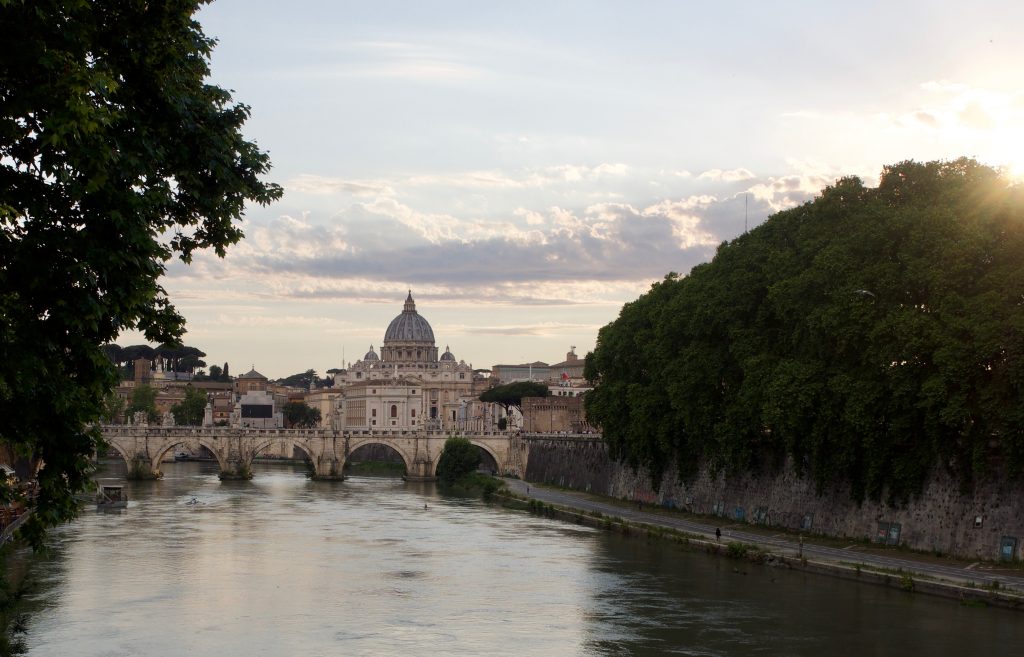
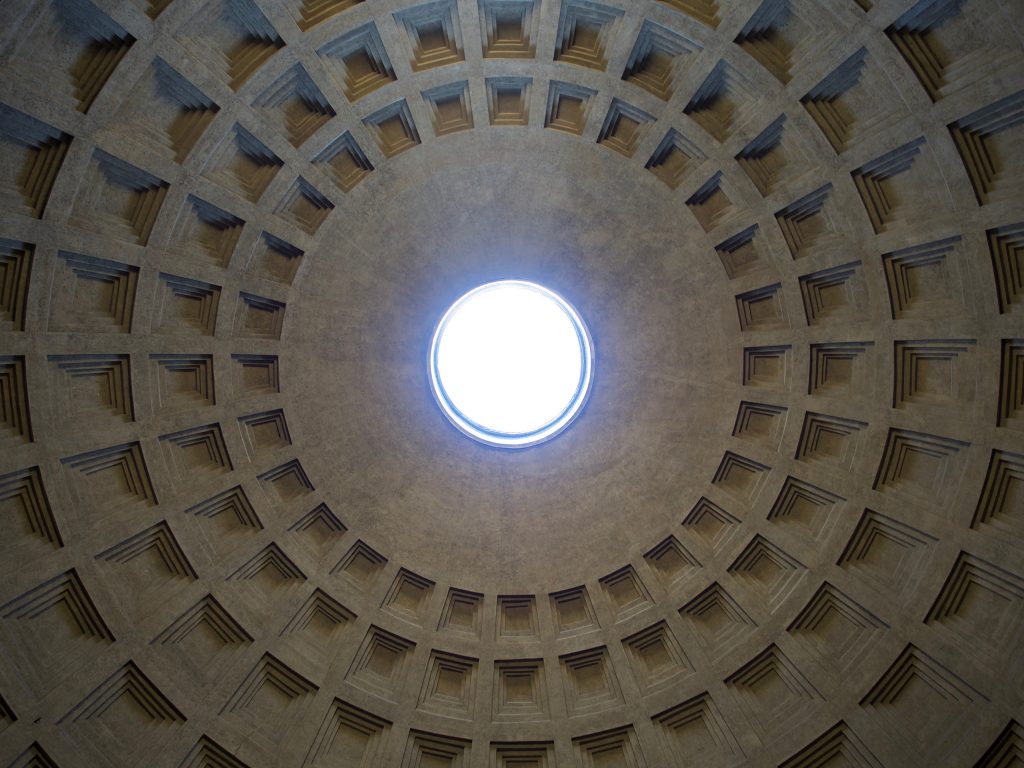
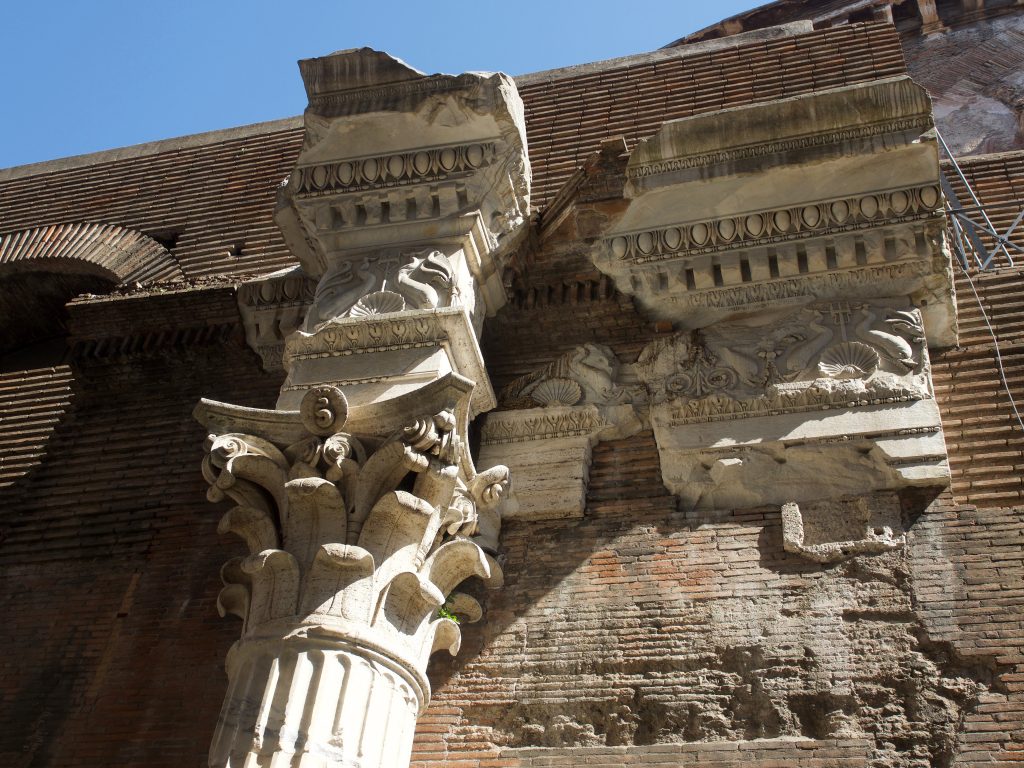
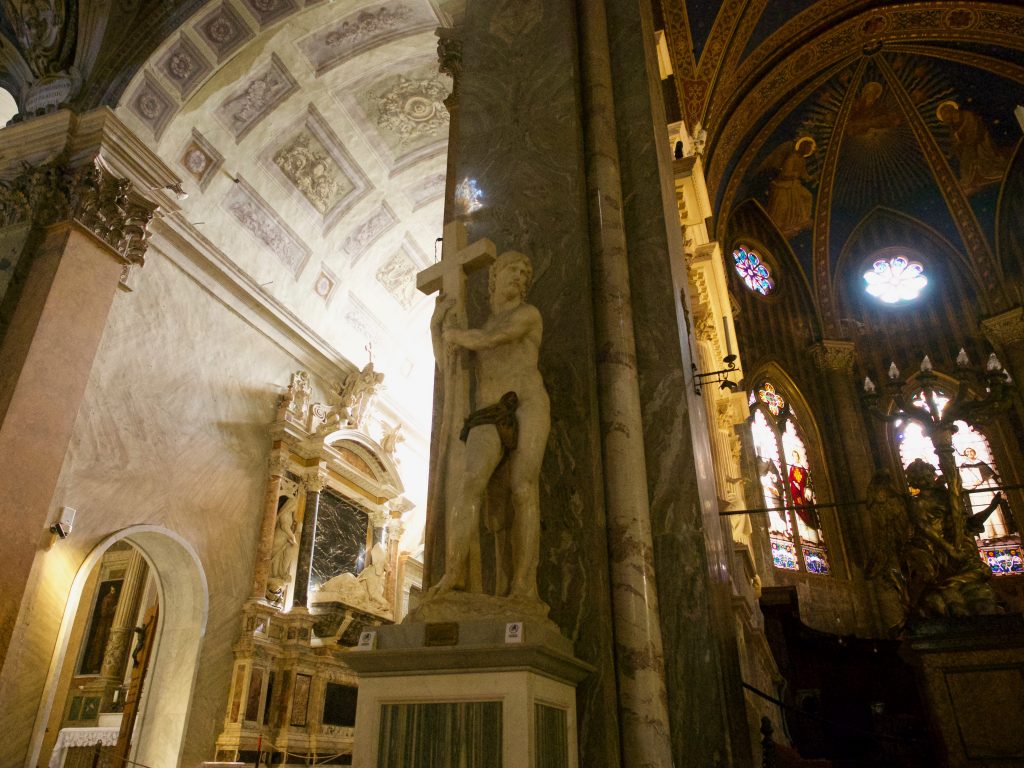
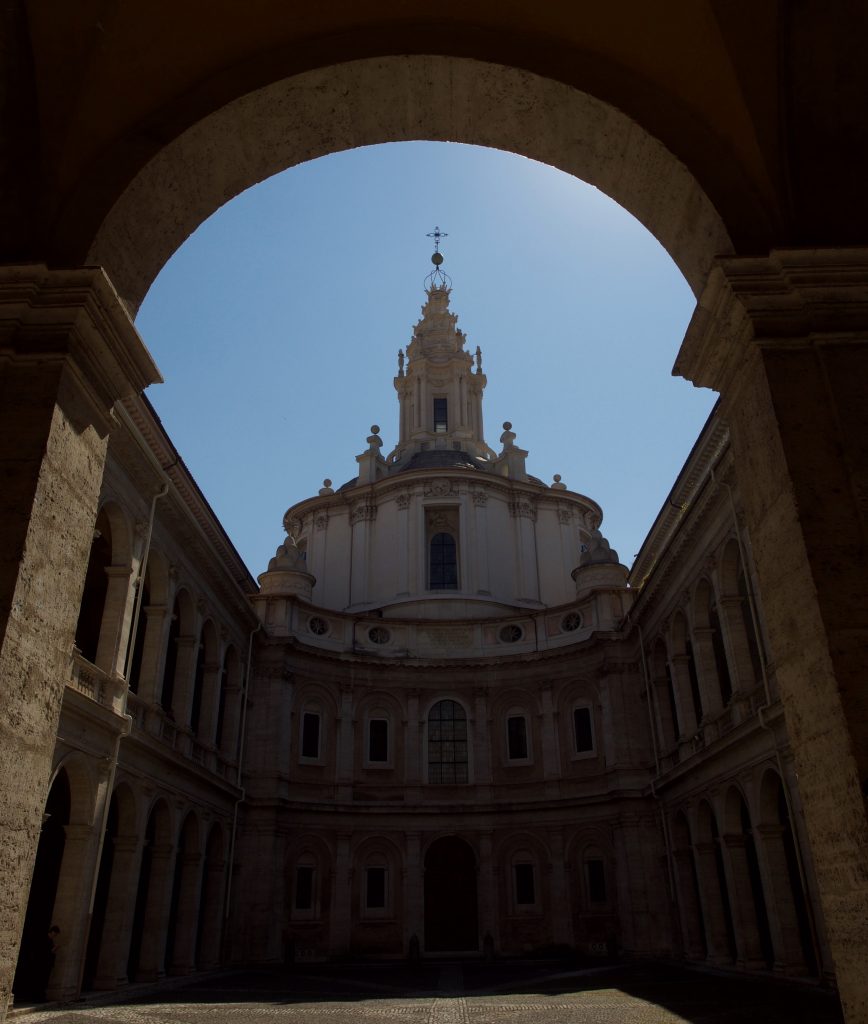
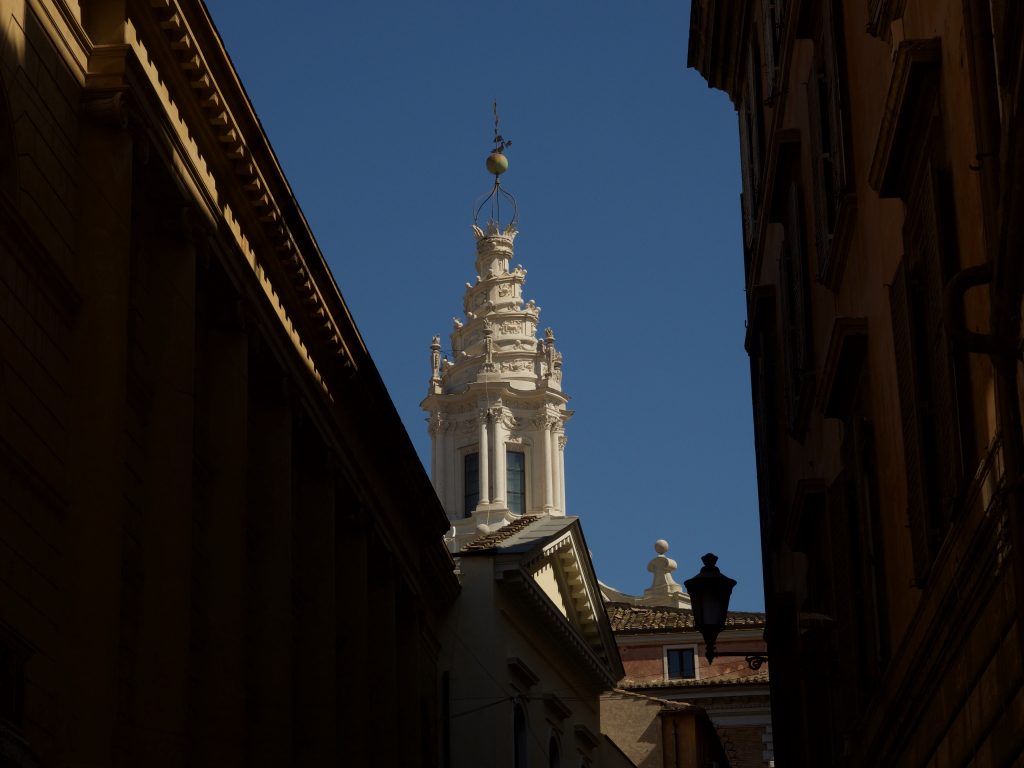
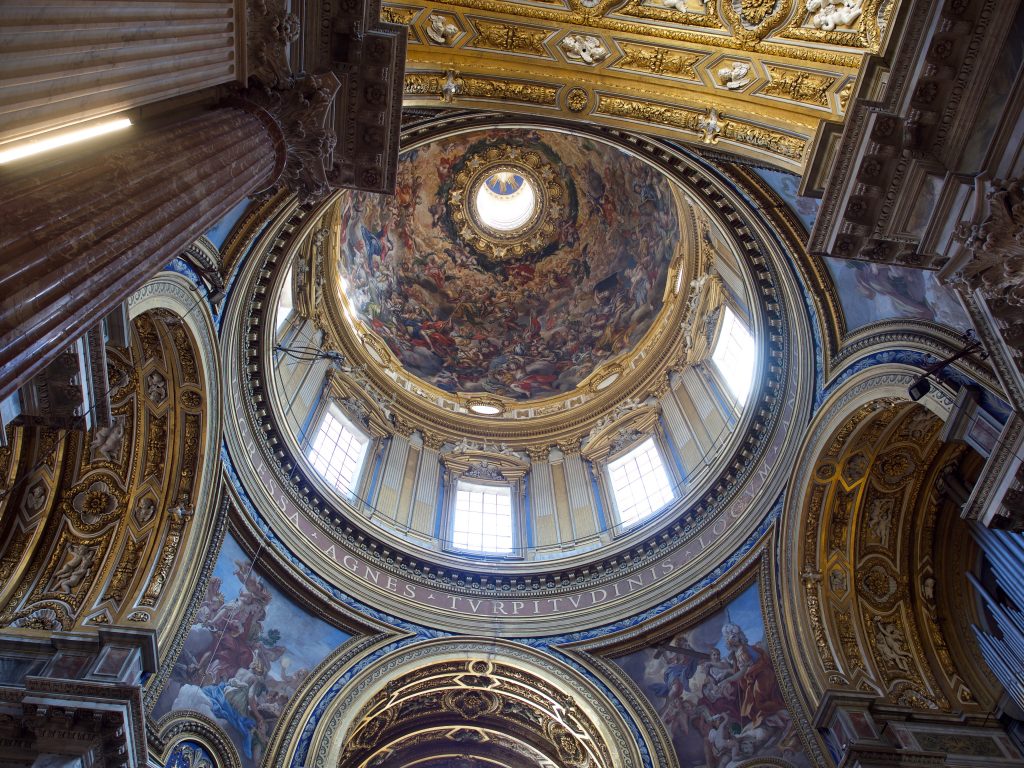
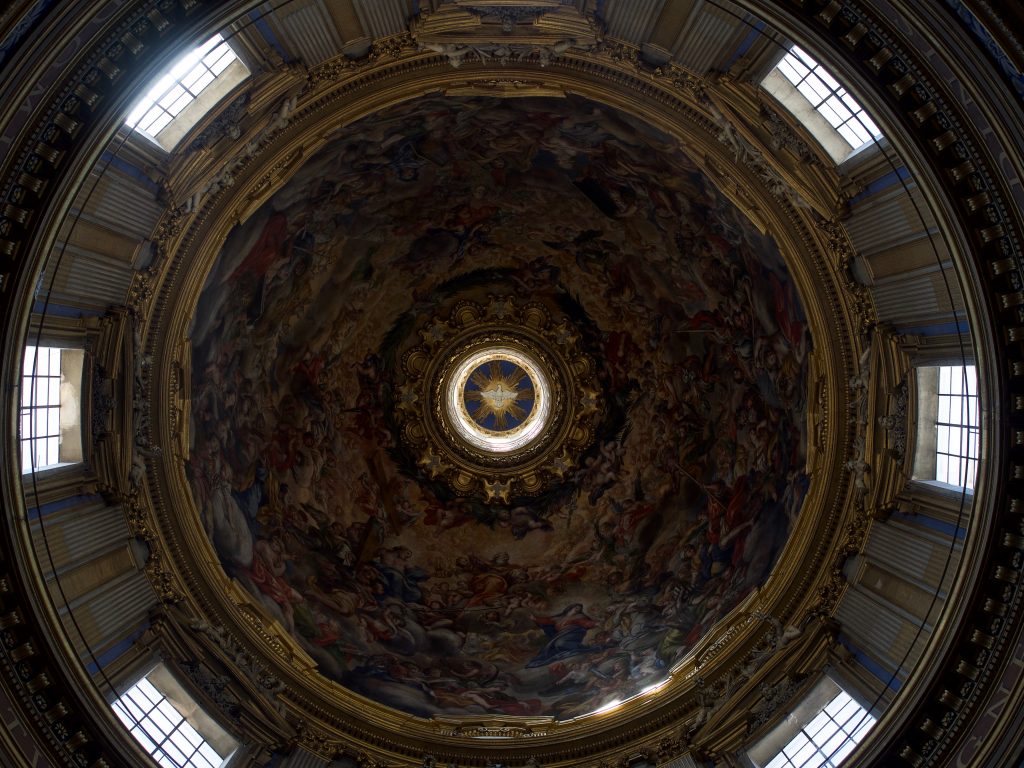
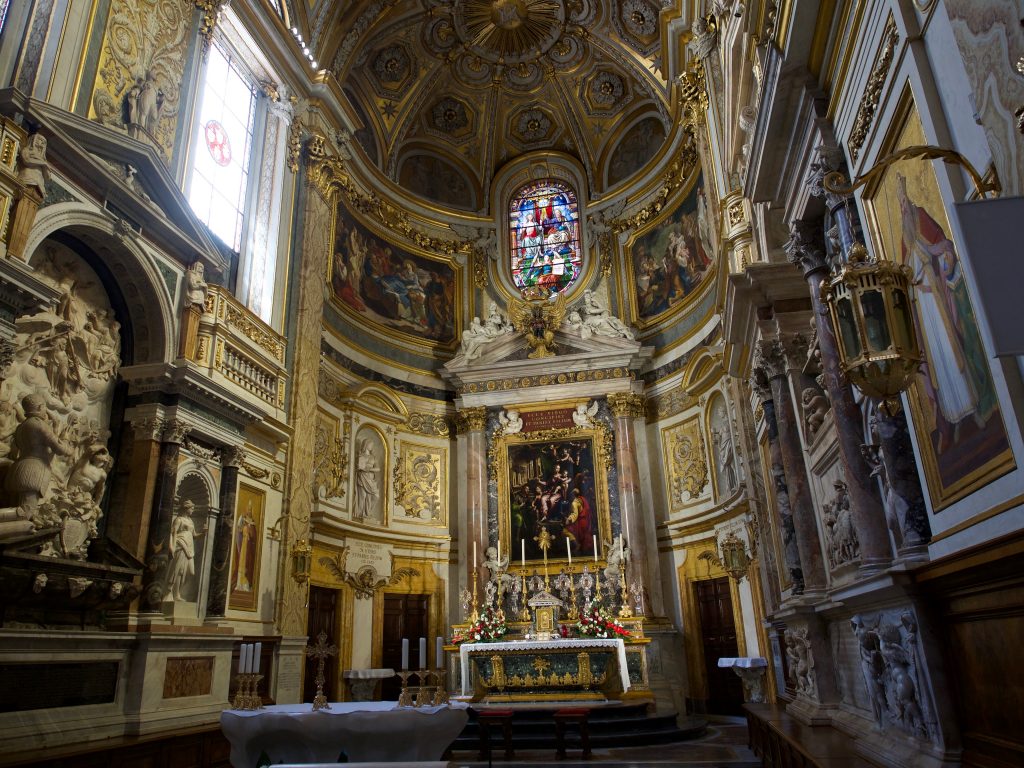
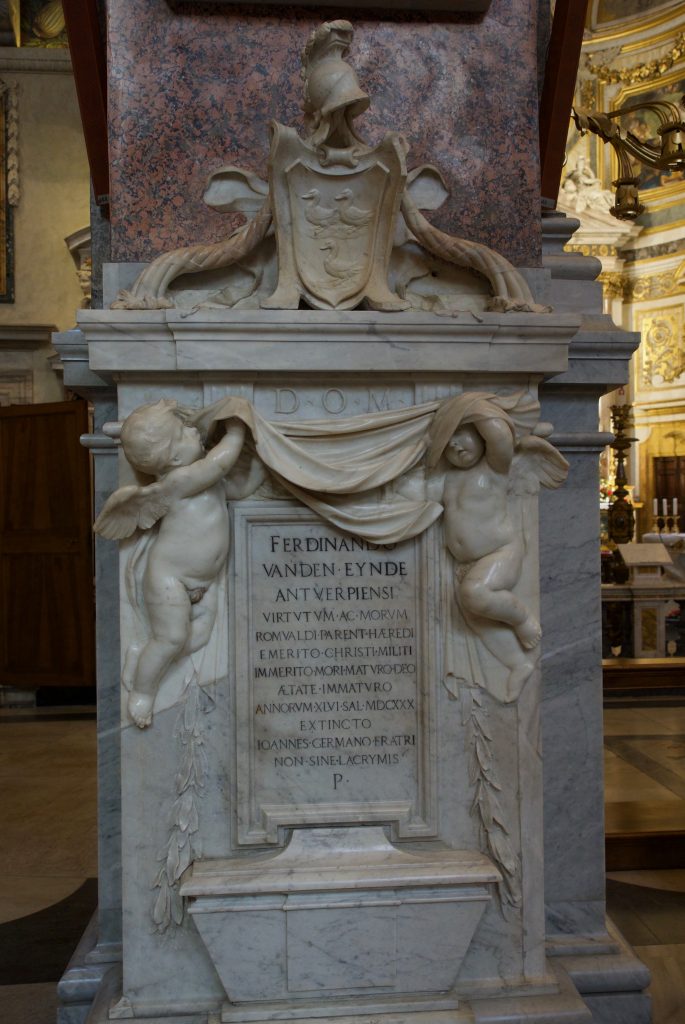
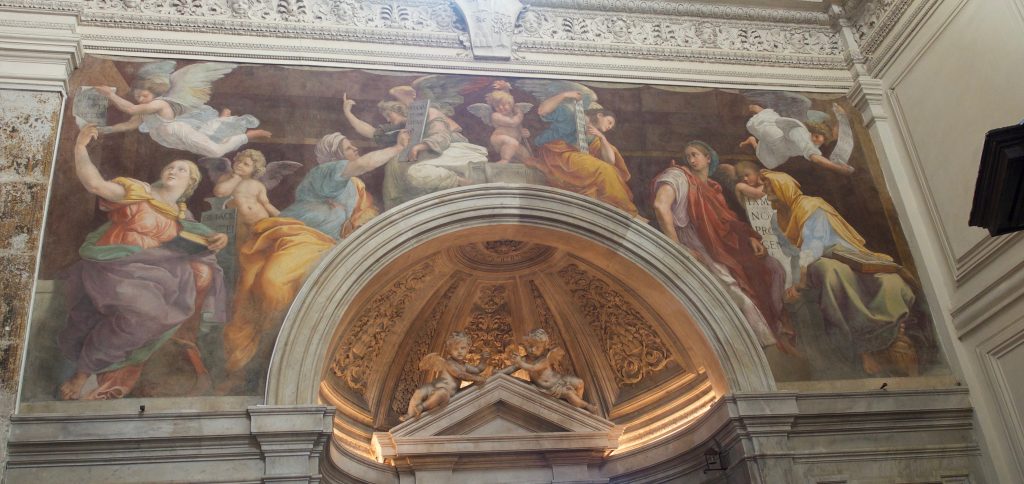
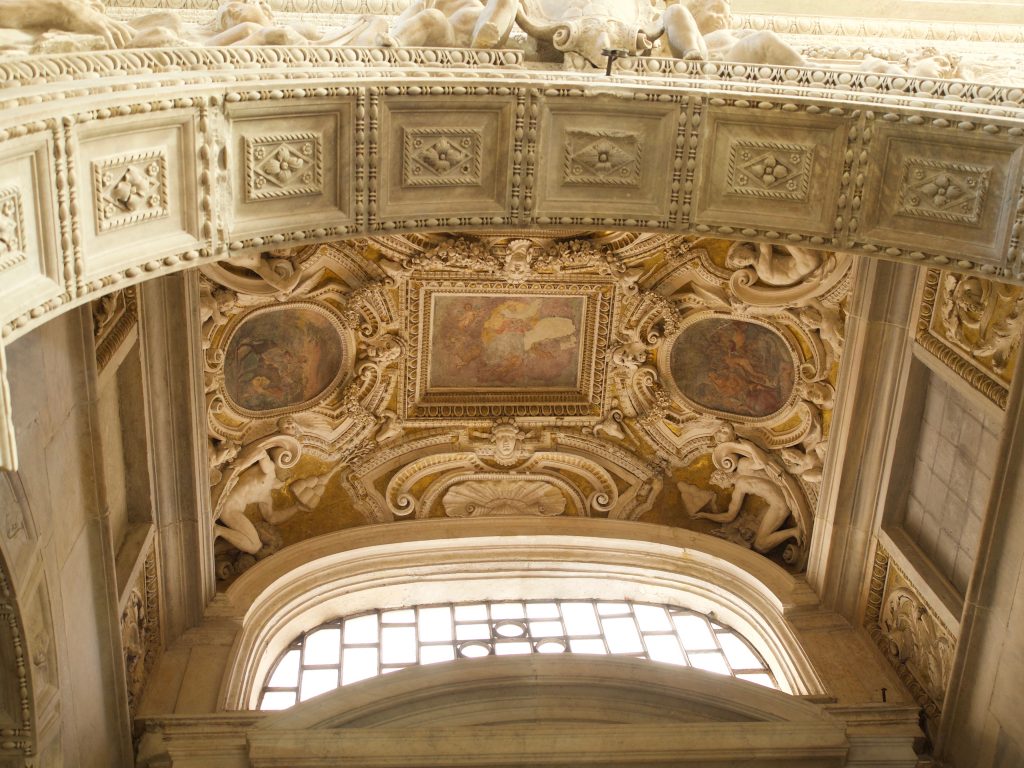
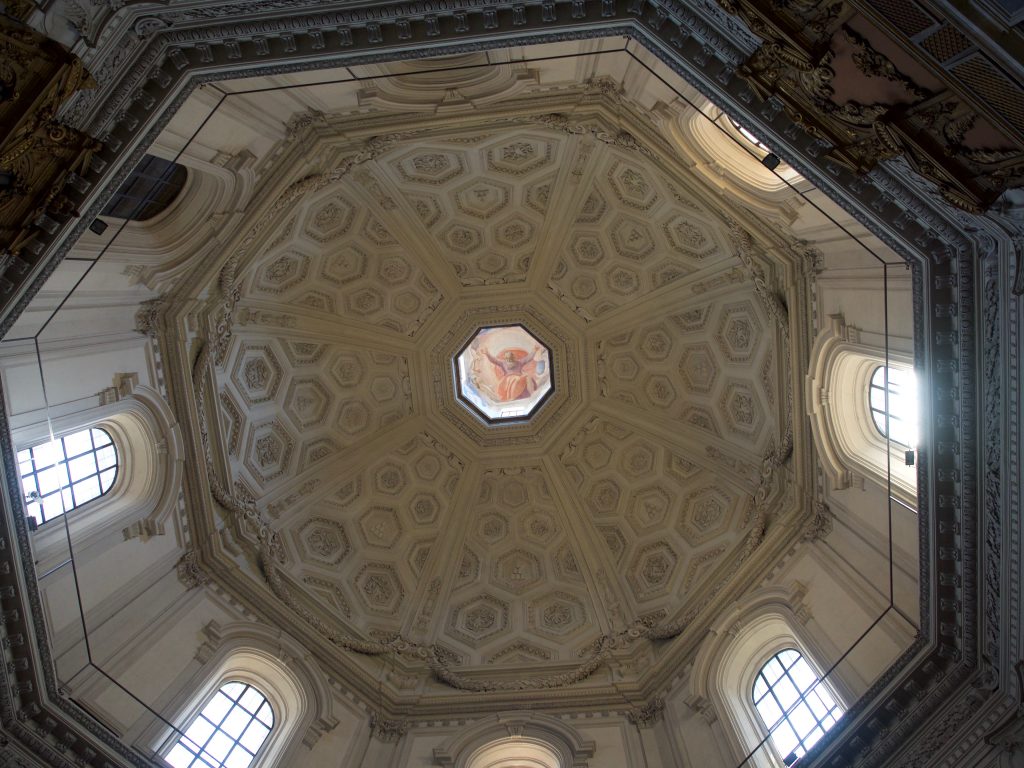
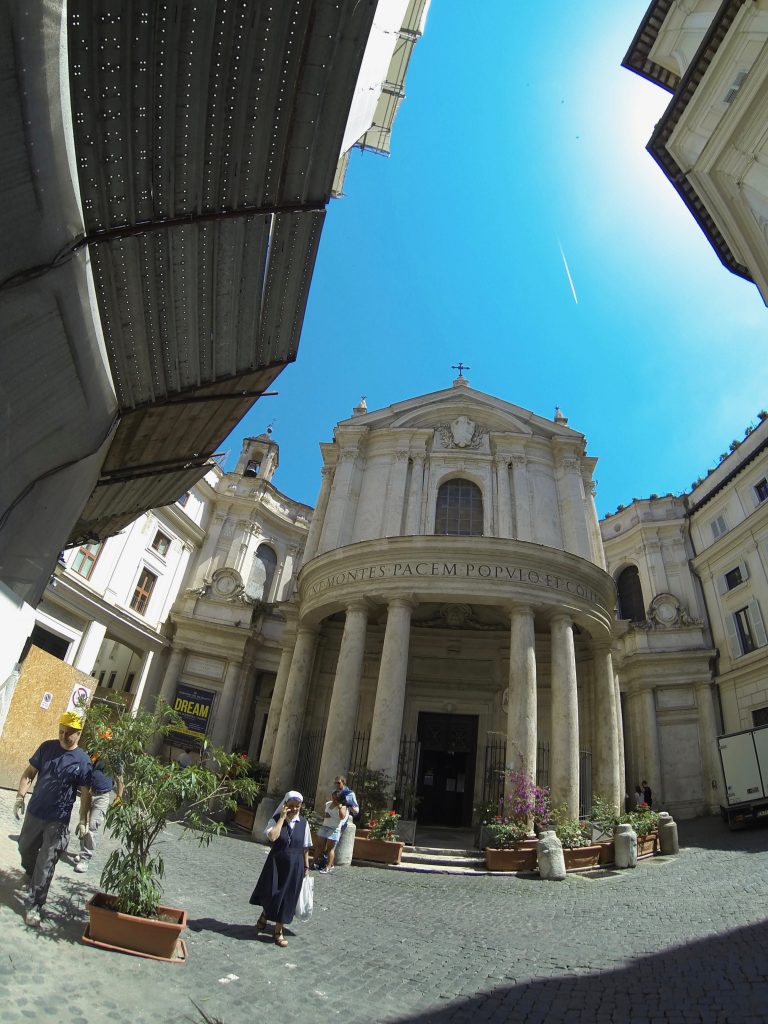
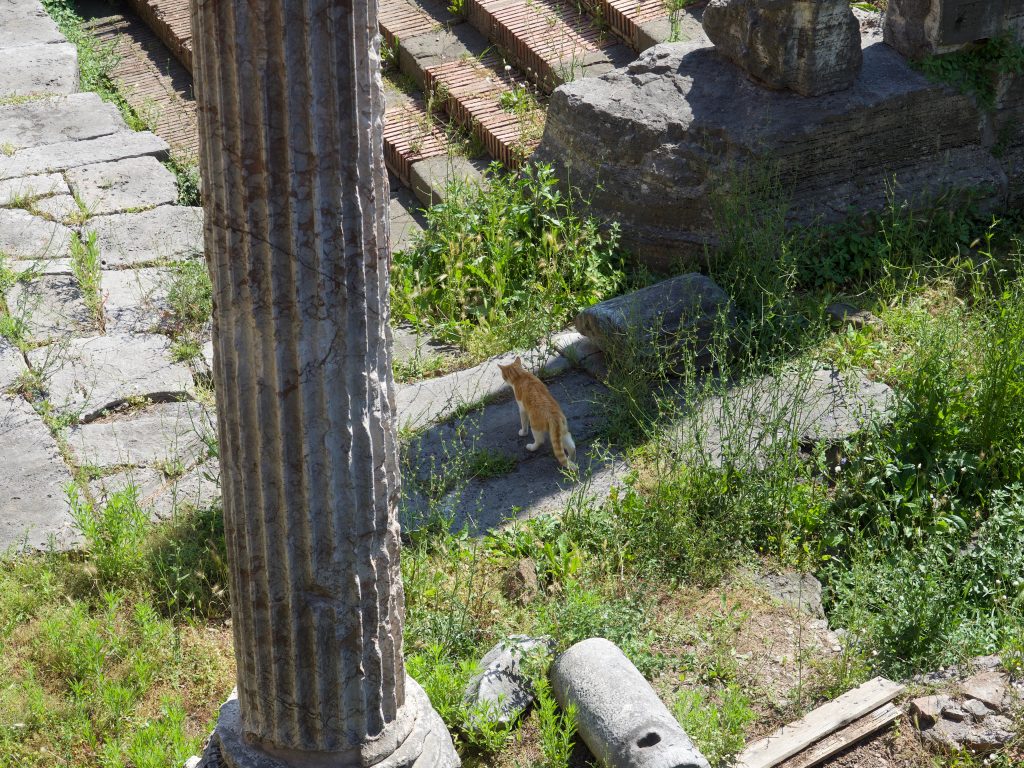

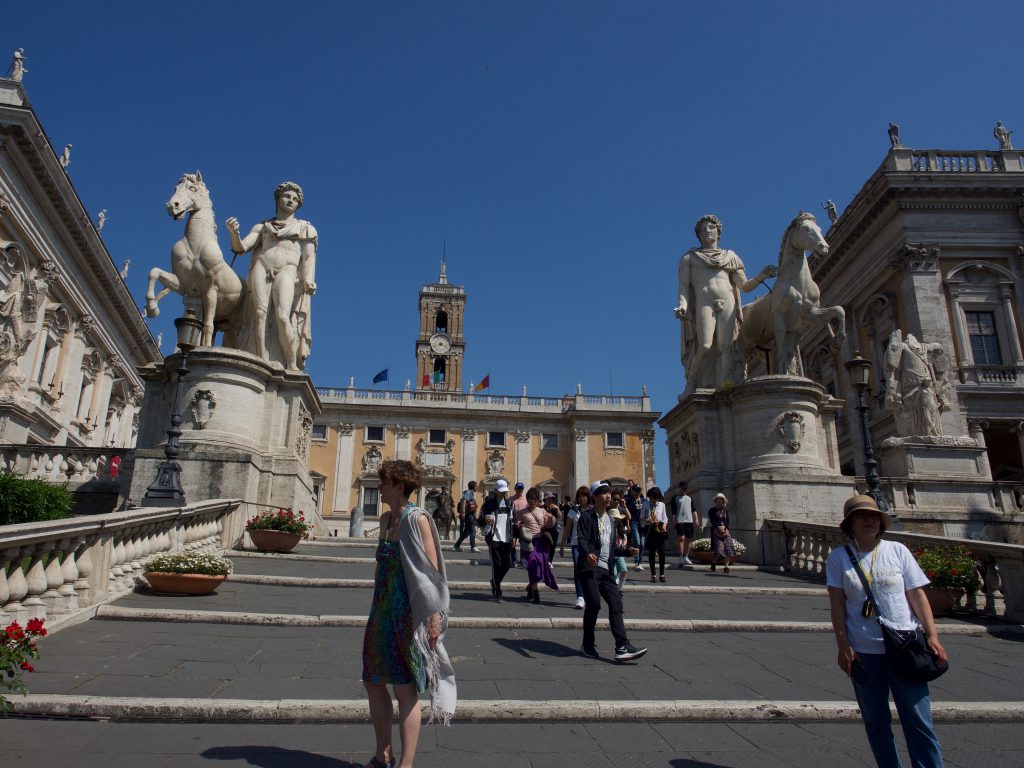
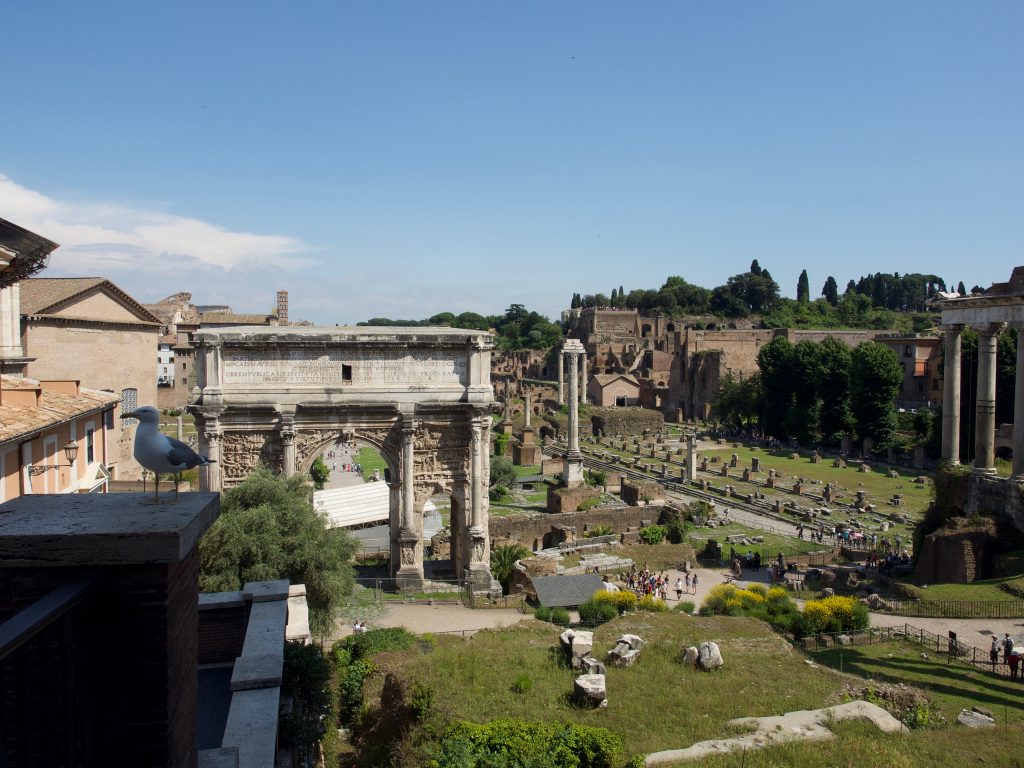
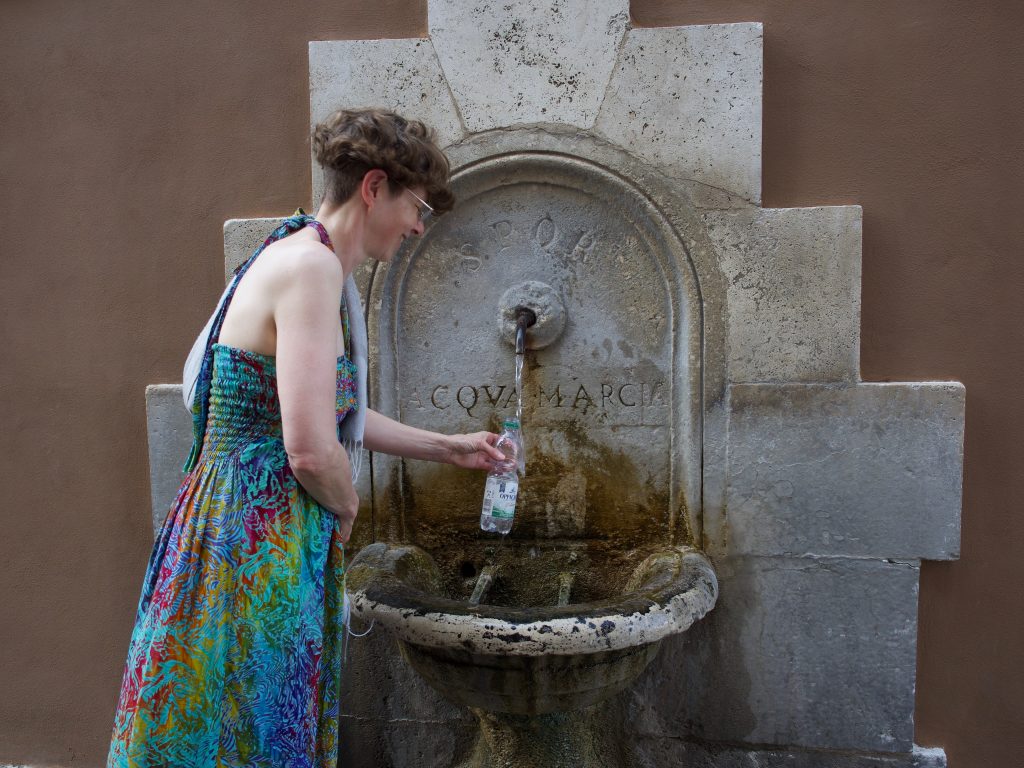
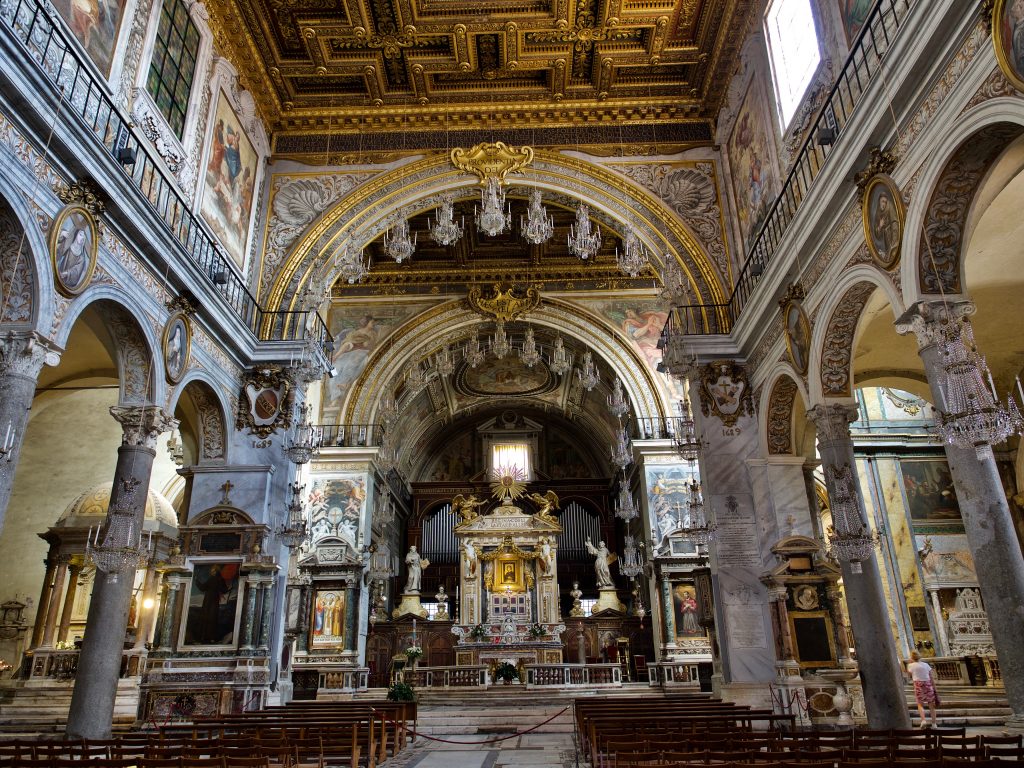
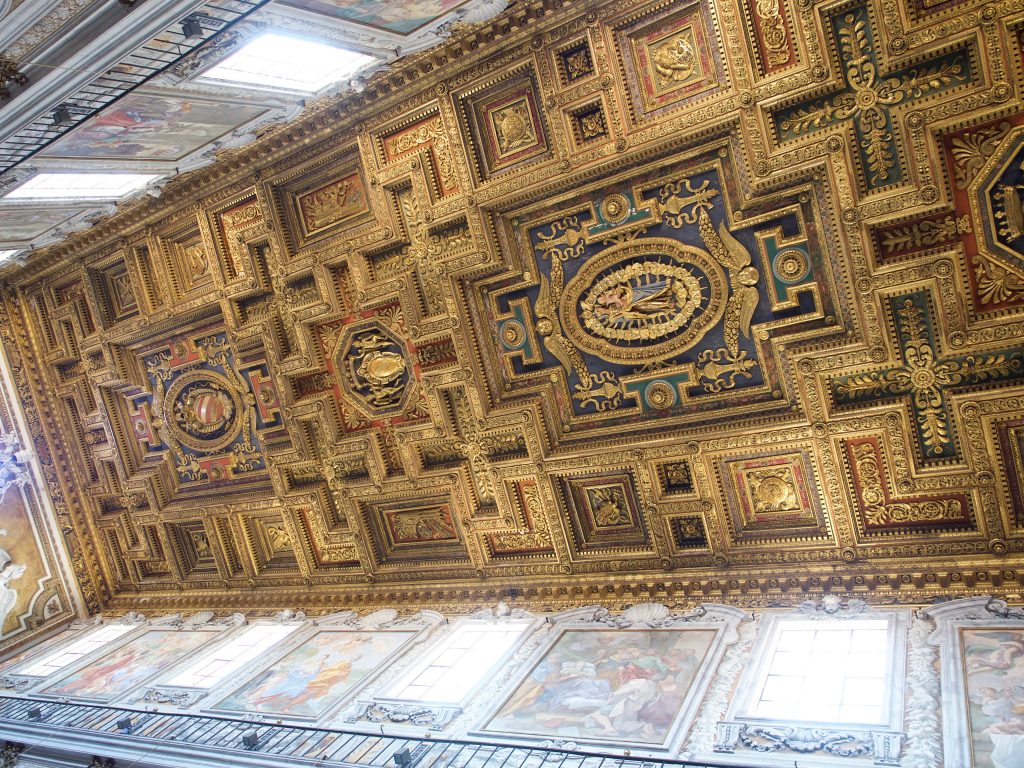
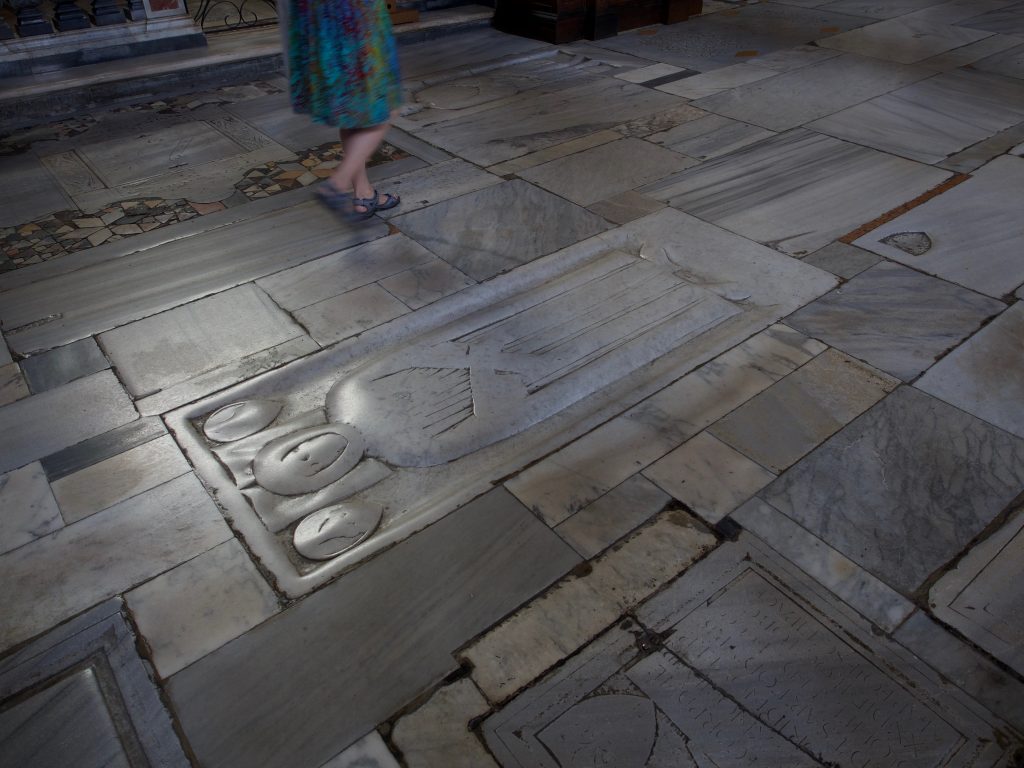
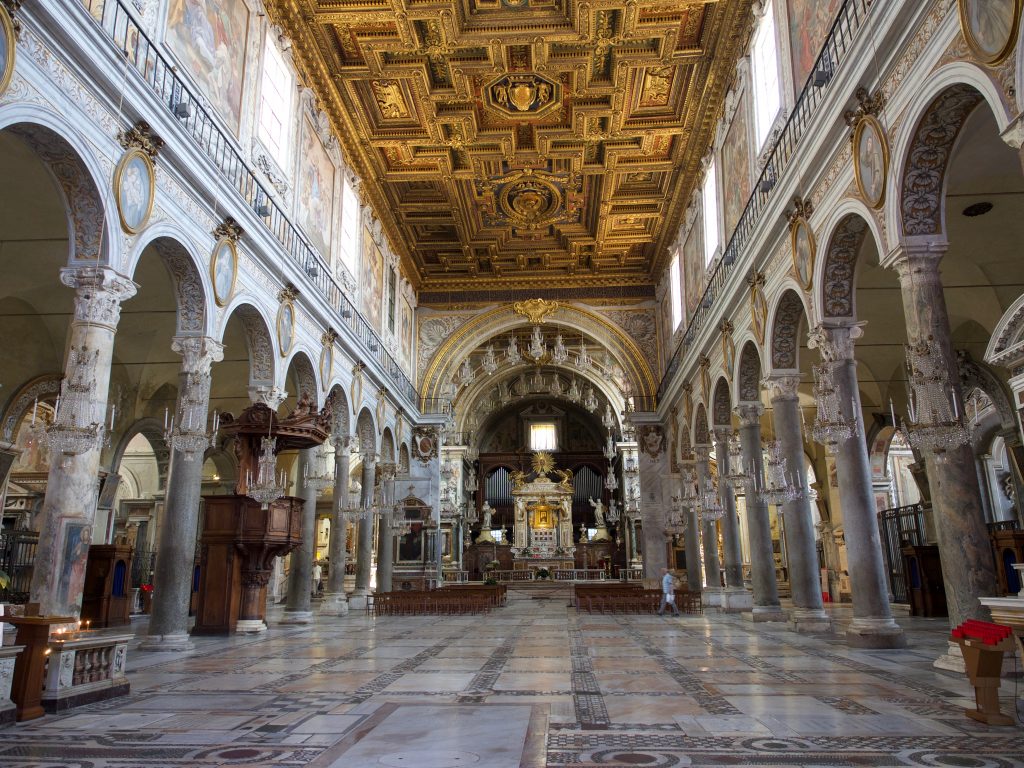
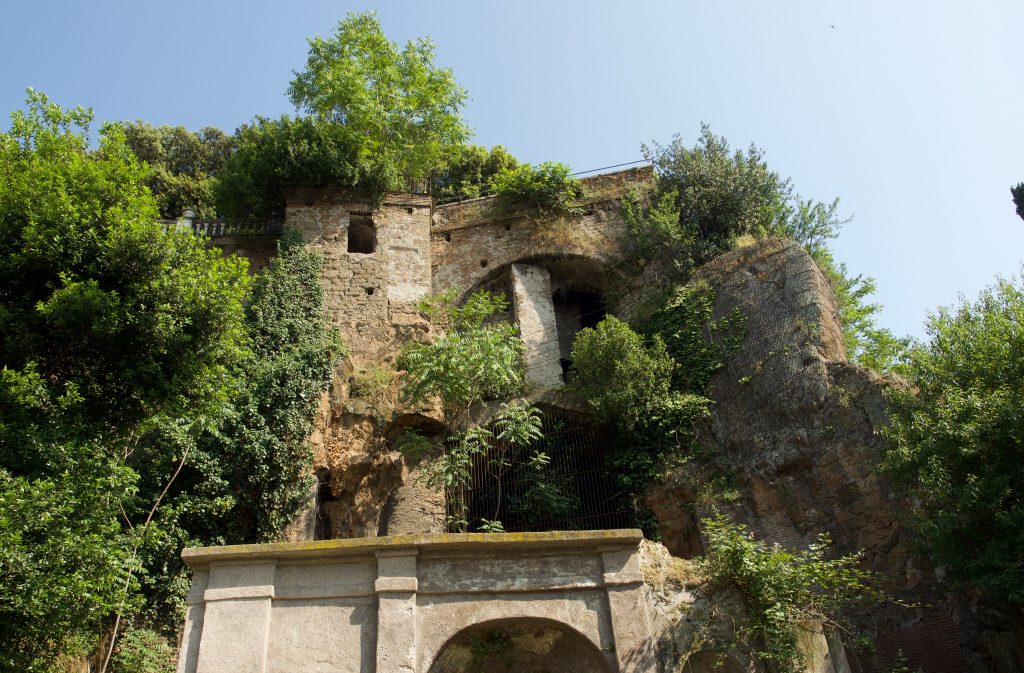
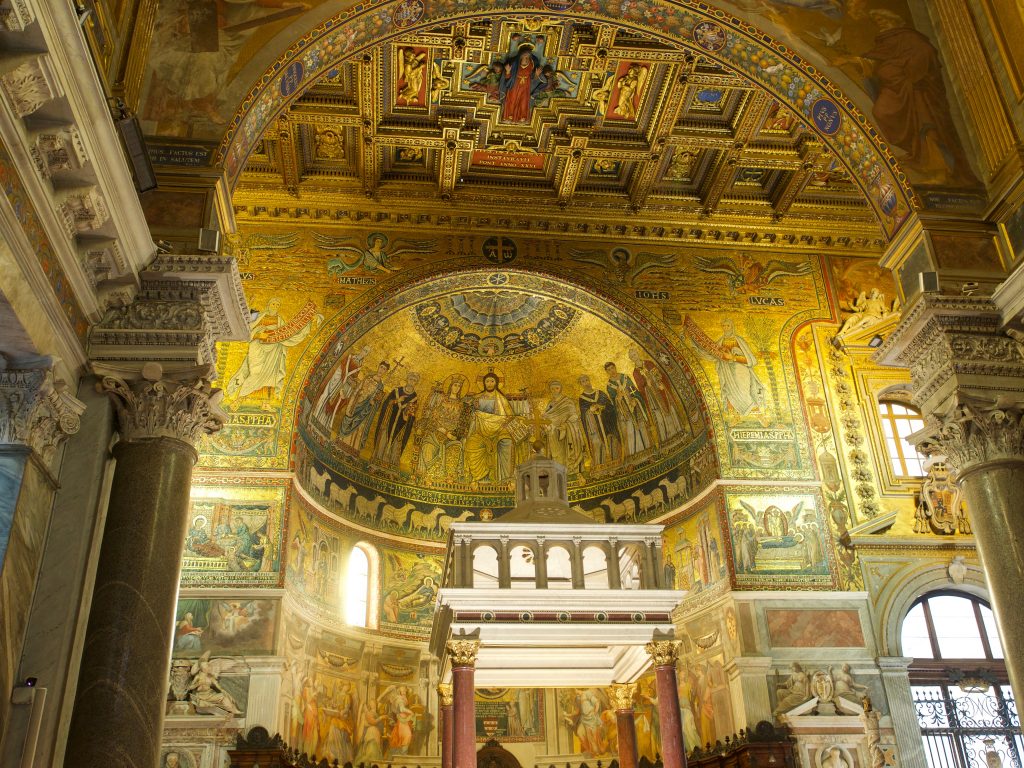
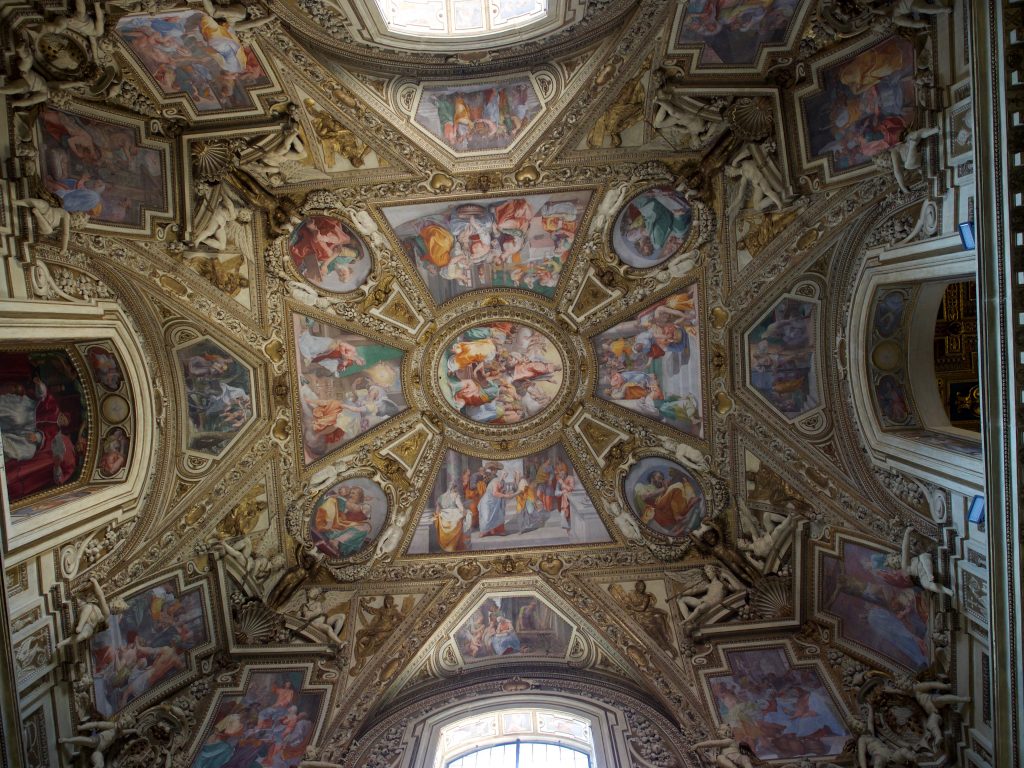

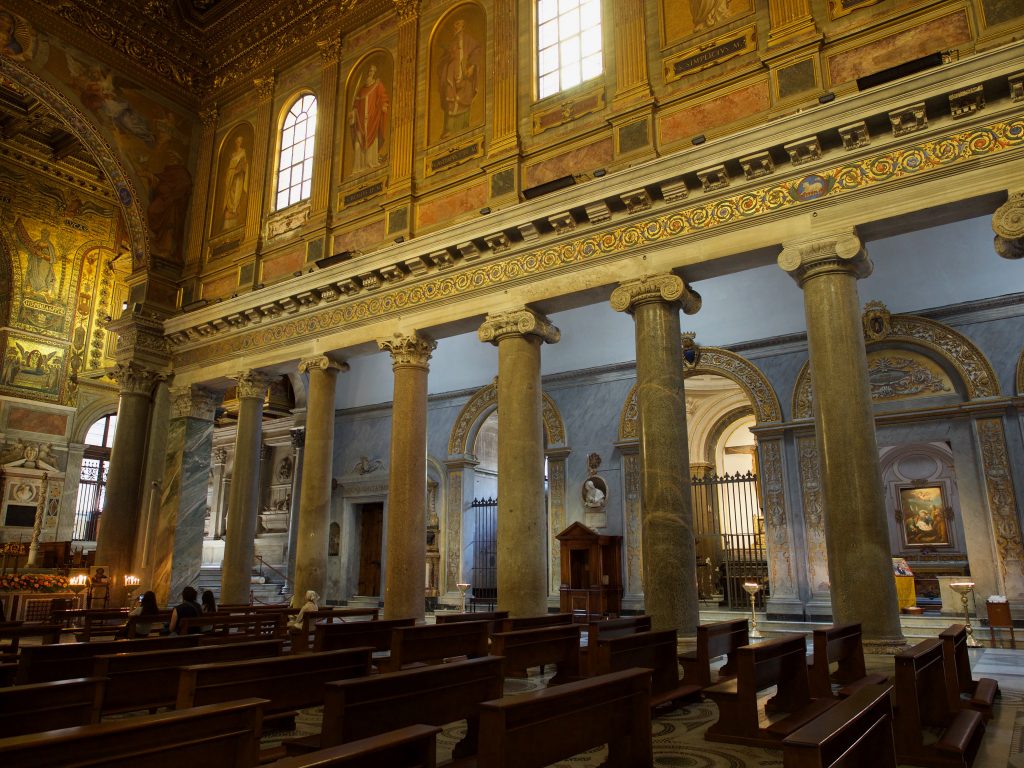
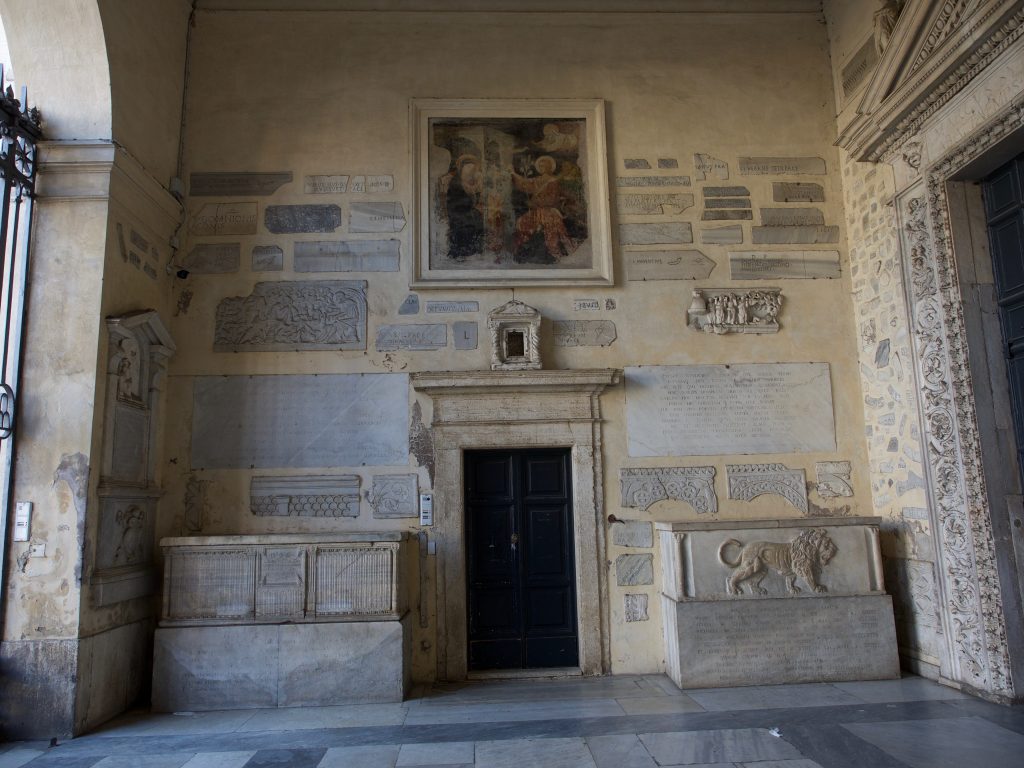
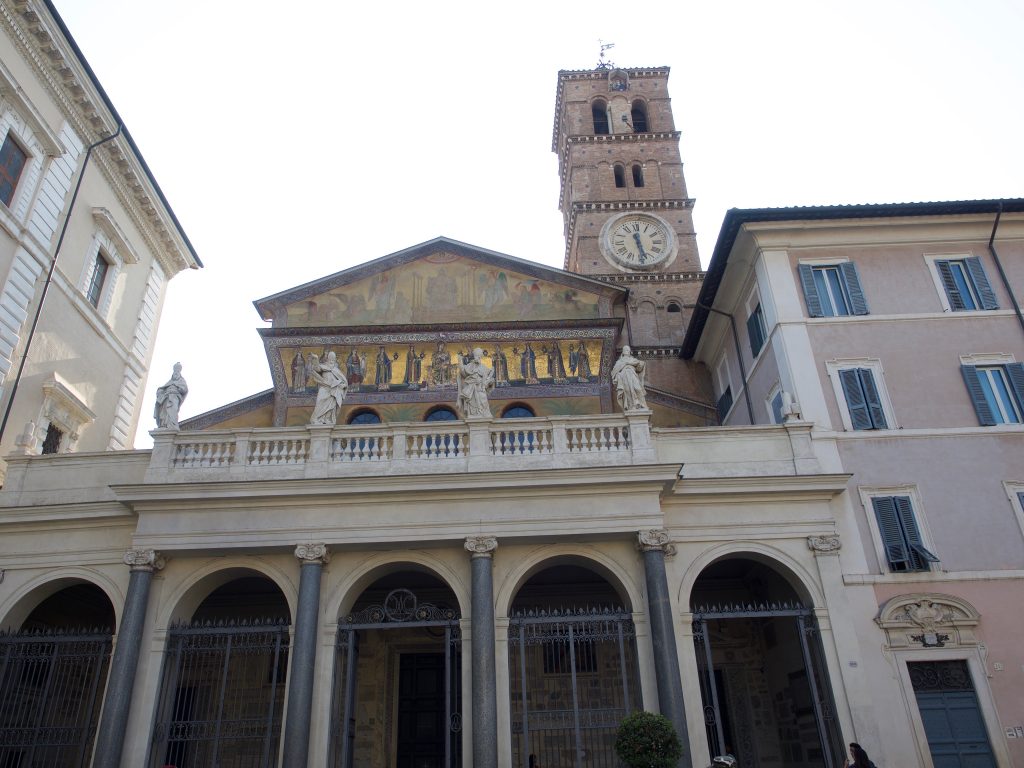
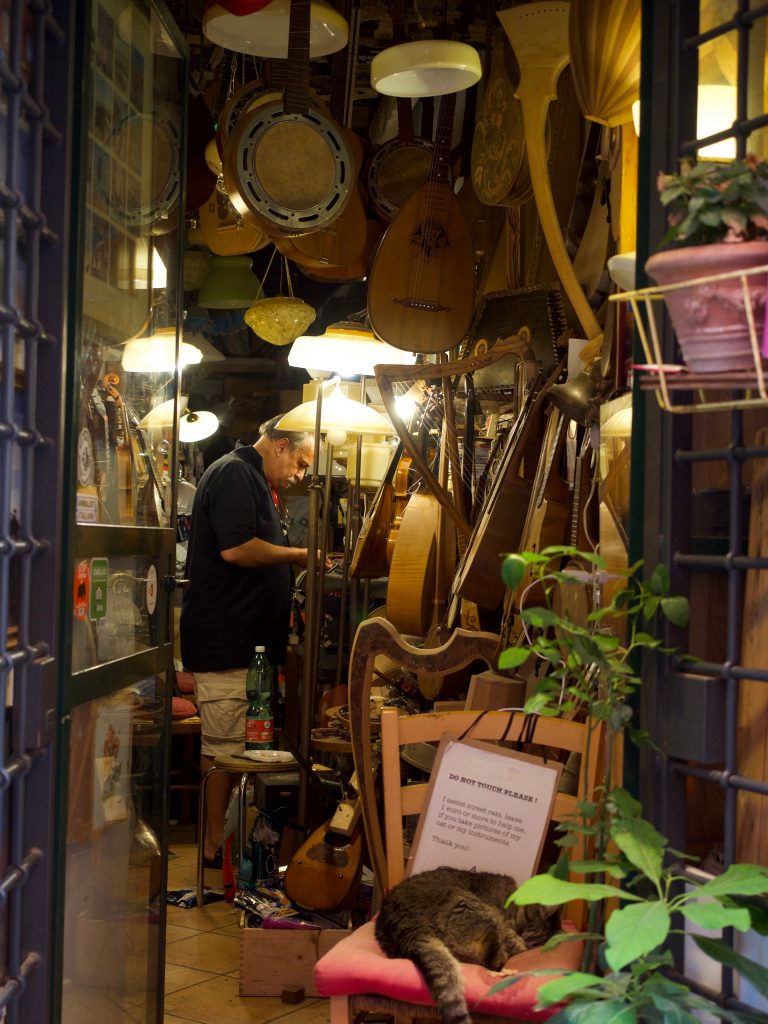
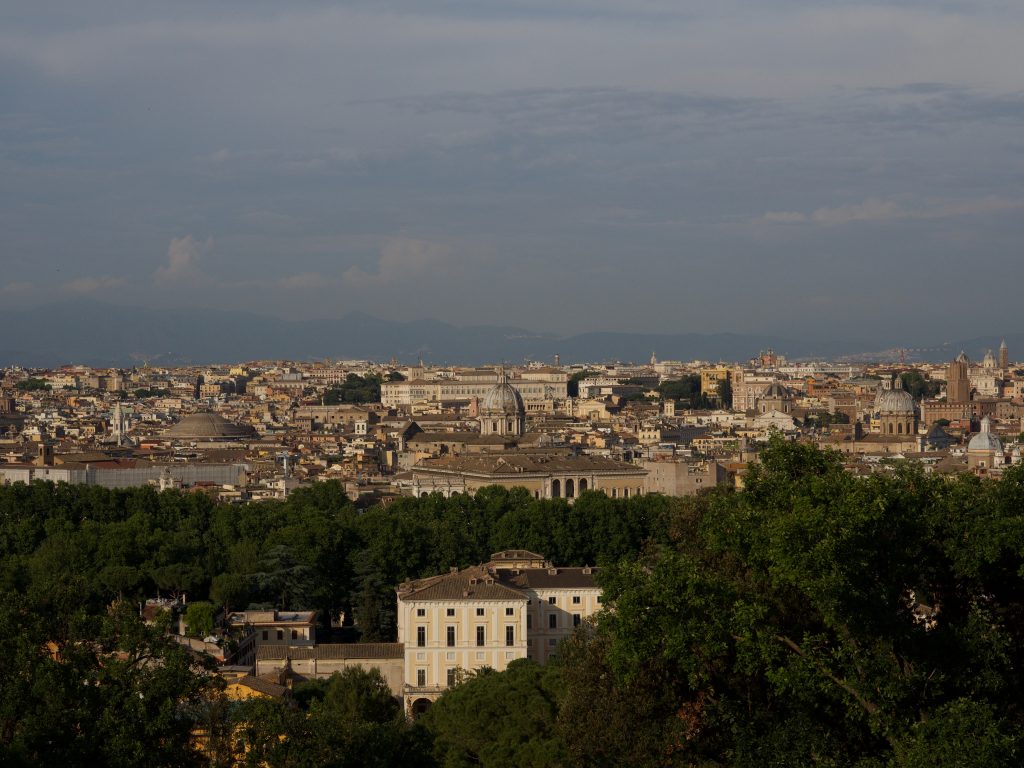
This was a VERY full day in Rome. We had a breakfast of yogurt and tea in our room, thanks to the little fridge & electric kettle, and then we set out about 8 am for an extensive walk through downtown, crossing the river by the piazza del Rovere and then heading toward the Pantheon, which actually wasn’t too crowded at before 10 am. I had gotten the tip that churches are much more reliably open before noon, and we did really get into almost every church we wanted to see. I opted to include them all here, so the descriptions here will be long and a little list-y. Even as an art history student, I had the blurring problem and still need to sort quite a bit—everything became one church, especially as so many of them, even the ones that were Renaissance churches, typically got a heavy-duty baroque upgrade, so that everything has sort of an encrustation of ornamental twirlers even on top of originally straight lines.
But we followed the advice of my Renaissance professor on what churches to check out and what to look for in them (for both Renaissance and Baroque), and that was really helpful. The Pantheon was, of course, impressive (I had seen it before), and the idea that the ancient Roman concrete held up so well for almost a couple of thousand years now, is mind-boggling. Walking around the outside of it, mostly brick and a couple of small spots where the marble „veneer“ was still in place (or stuck back into place), we tried to imagine what it would have looked like in Roman days, but failed. But it was certainly fun to see Roman engineering and economy at work with the brick-and-concrete concept with just that marble outside covering to make it look „all marble.“ We also visited the Bernini elephant / obelisk on the little piazza behind the pantheon, and the church right there, S.Maria Sopra Minerva, where Fra Angelico was buried and where we saw Michelangelo‘s Christ the Redeemer.
After that, our path and the churches become kind of a blur, but to the best of my memory, after surrounding the Pantheon, we headed in the general direction of the Piazza Navona again, and went briefly into S. Eustachio in Campo Marzio, of which I remember nothing—but we have a photo! Once I spotted the top of S. Ivo alla Sapientia, I knew that’s where we needed to head next, but sadly, we couldn‘t go in. This church has a really cool Baroque design by Borromini, and we could see some of that from the outside in the courtyard, but without going in, it was not nearly as clear how ingenious the design is. But as we walked away from it, we got another glimpse of the lantern atop the cupola from a different angle and saw that it was a fancy spiral. Quite the quirky baroque thing to do. Borromini was really the king of that kind of thing.
Borromini also had some impact on S. Agnese in Agone, one of the two churches on the Piazza Navona, where we headed next, although his rival and enemy Bernini was also involved. That church stood out to me mostly because it was the first I saw where the altarpieces were high-relief carvings (with all the depth effects one could wish for) rather than paintings. It also has a super decorated cupola and is just completely decked out with ornamentation. Baroque is exhausting.
Across from S. Agnese is another church, Nostra Signora del Sacro Cuore, which we visited but about which I knew nothing. Wikipedia tells me that it used to be the church of the Spanish community in the Renaissance, but then that changed in the 17th century, and that parts of it were removed to make room for a street. But being in it, I couldn‘t tell it was an „unimportant“ church and I still wonder how one does that. While they don‘t all look the same to me like they used to, I still have the impulse to ask, as with books, how some of the decisions on the canon—on what‘s important and what isn‘t actually get made and also how they change.
As per Andrea Bolland‘s recommendations, we then hit another two churches: the church of the German Catholics in Rome, S. Maria dell‘Anima, a hall church, which I usually associate with simplicity, but which again was endowed with tons of baroque ornamentation. We admired a tomb that showed the fat putti of „the Flemish master of rendering baby flesh“ (as Bolland puts it), Francois Duquesnoy, and then moved on to the actual Renaissance church kitty corner, S. Maria della Pace, with a famous facade and courtyard by not one but two Renaissance architects (Cortona‘s facade, Bramante‘s courtyard), and the Chigi chapel, which has a fresco by Raphael with a Sybil that is supposed to be his answer to Michelangelo‘s Sybils on the Sistine chapel ceiling. The neighboring altar also had these interesting-looking marble sphinxes underneath the marble figures underneath the marble tomb sculptures of a couple. The courtyard presented an interesting twist, because an art installation that covered the whole open sky of the courtyard with clear plastic was being removed by means of hydraulic posts on all four corners. So we watched for a bit while this was happening.
At this point, we needed a break from churches and lunch, so we headed home (our way home ALWAYS includes the incredible „long view“ of St. Peter‘s from the Via della Conciliazione), bought a couple of salads at the PAM store on the way, and had salad, focaccia-style bread, and salami for a very satisfying lunch at home. Mark took a little nap while I read up on my art history of what we‘d just seen (but it doesn‘t seem to all stick), and around 2 pm we set out again.
Our first stop was Rome’s Florentine church, S. Giovanni del Fiorentini, which again has an altar by Borromini, and from the steps of which we looked down (as per Andrea‘s recommendations) one of the very first straight streets of Rome, the via Giulia, created in the early 16th century. We walked the via Giulia (I am, after all, here to experience Renaissance Rome), which leads past several Renaissance palazzos (now often embassies or Italian government buildings, we noticed—typically with soldiers guarding the entrance. At the palazzo Farnese (which we couldn‘t access), we turned towards the Largo di Torre Argentina, because that is where one goes to see cats on Roman ruins. There is actually a cat sanctuary, clearly funded by the cat lovers of Italy, England, and America, where street cats get sterilized (nicked ear and everything) and released (the ones who would not survive in the streets, especially blind cats, get to stay), and that clearly attracts more tourists than the ruins themselves, even as a docent was happy to explain to people what they were seeing below in the ruins.
I hadn‘t realized how very close we were at that point to the Capitoline hill until we were standing right in front of the piazza d‘Aracoeli at the bottom of the stairs that lead up the hill. I spent a half a day here when I was in Rome in 2010, so I knew what to show Mark—so we climbed up, looked down the length of the forum, glanced at the copy of the bronze Marcus Aurelius on Michelangelo‘s plaza, and also visited the church, S. Maria in Ara Coeli (which translates into „the altar of heaven“). Lots of gold and ornament, but I find this church really interesting because of the flat coffered ceiling (I remember seeing it in 2010 and being so confused—how was this even a church? I was trained on German Gothic and Romanesque style, and flat ceilings were not in my register of what a church should be. There was some very cool natural light in this church making certain golden spots glisten, and the extremely worn marble grave stones in the floor were very cool. We did, however, use the back stairs to go in and out, rather than the endless front stairs which we watched some tourists climb.
We then walked by the Teatro Marcello (a „mini coliseum“) and other Roman ruins that show the „underneath“ of the Capitoline Hill, and then made our way onto the Isola Tiberina. I remembered some very yummy gelato there, but we couldn‘t sit down on the island across from the „broken bridge,“ the ponto Rotto (as I had done before), because the area was being set up for a concert, festival, or the like. So we went across and sat on a wall, watching the Tiber from there and then made our way into Trastevere.
I love the even-windier little streets there as I had before, but we also went to S. Maria in Trastevere, which was very cool, because part of it is so old. The Italo-Byzantine mosaics from the 13th century are an unusual sight for Rome, and the huge granite columns were actually recycled (up-cycled?) from a Roman complex (presumably the baths of Caracalle). The campanile is also in medieval style, and even though the facade was „classicized“ later, this church does have a really different feel. We left right as some people were coming in for a 5:30 pm service, and then found ourselves a little cafe with snacks and appetizers and had a „pizza romana“ (which is really a sandwich on a slice of focaccia bread) and some breads and cold cuts. Good but not great—we really do not quite know how to choose good food here.
The last part of our day was then to walk from Trastevere to the Gianicolo park, up the hill to the piazza Garibaldi and then back down the hill toward the Vatican, with gorgeous views of Rome all the way along. It was great to see from a distance what we had seen close up on the other side of the Tiber, and the great surprise (which shouldn‘t have been one) was how silly and undistinguished the Pantheon looks from afar, compared to all the marble and painted stucco everywhere else. Just like a giant shallow clay bowl turned upside down. I assume it was all marble clad or at least plastered (how, though??? Gotta do some research on that) and that the marble was turned into lime in the limekilns of the Middle Ages.
We were home about 7:30 and good and tired after over 12 miles of walking! But we ducked out to buy juice, sparkling and cookies, to finish our day with a nice little dessert date at our rickety dinner table—what a long but great day!